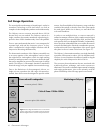
ODYSSEY
TM
Please take note of the jumper clips installed under the
binding posts. These clips attach the high and low frequency
sections of the crossover together. Leaving these in place,
connect the (+) wire from your amplifier to either red bind-
ing post and the (-) wire from your amplifier to either black
binding post (See Figure 2).
Bi-Wire Connection
This method of connection replaces the jumper clips installed
under the binding posts with individual runs of speaker
wire from your amplifier. This doubles the signal carrying
conductors from the amplifier to the speaker, thus direct-
coupling each portion of the crossover to the amplifier.
To bi-wire you must first loosen the binding posts and remove
the jumper clips. Connect one set of wires to the upper set of
binding posts which connect to the panel of the Odyssey.
Then connect a second set of wires to the lower binding
posts which connect to the woofer. Next, connect both sets
of wires to the appropriate terminals on your amplifier.
Please take care to connect both (+) wires to the (+) ampli-
fier terminals and both (-) wires to the (-) amplifier terminals.
This is known as a parallel connection (See Figure 3).
For those that desire ultimate performance, the Odyssey
may be passively bi-amplified using the existing internal pas-
sive crossover elements.
WARNING! Only after the jumper clips are
removed may you connect individual runs of
speaker cable from your amplifiers to the high
pass (ESL) and low pass (WOOFER) Signal Input
binding posts. Damage will occur to your ampli-
fiers if the jumper clips are not removed.
This method takes the bi-wiring concept one step further.
Now you will have a dedicated channel of amplification
directly connected to the high and low pass sections of the
Odyssey crossover. There are two different methods for
bi-amping with two stereo amplifiers. The first and most
common is referred to as Horizontal Bi-amping. The second
method is referred to as Vertical Bi-amping. With either
method you may use two stereo amplifiers or four mono
amplifiers, or two mono amplifiers and one stereo amplifier.
Get the idea? With either form of passive bi-amplification,
your preamplifier must have dual outputs. If your pream-
plifier is not so equipped, you must either purchase or
construct a “Y” adapter.
Horizontal Passive Bi-Amplification
Horizontal bi-amping allows you to use two different types,
models or brands of amplifiers (i.e. tubes on top, transistor
on the bottom). However, we recommend that you use
two identical amplifiers (i.e. same brand and model).
If you must use two different amplifiers, it is essential that
they have the same gain or that one of the two have adjustable
gain so that you can match their gain characteristics. If the
Single-Wire Connection Passive Bi-Amplification
Figure 2. Single-Wire Connection. One Channel shown.
Amplifier
Jumper clips
in place,
full-range
speaker output
ESL
Woofer
Bass Control
-3dB
flat
Figure 3. Bi-Wire Connection. One Channel shown.
Amplifier
speaker output
Jumper clips
removed
ESL
Woofer
ODYSSEY
TM
Bass Control
-3dB
flat
6 Operations


















